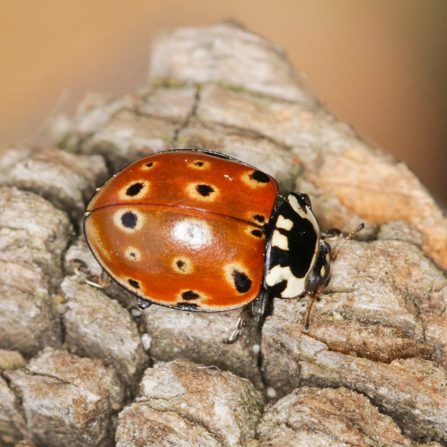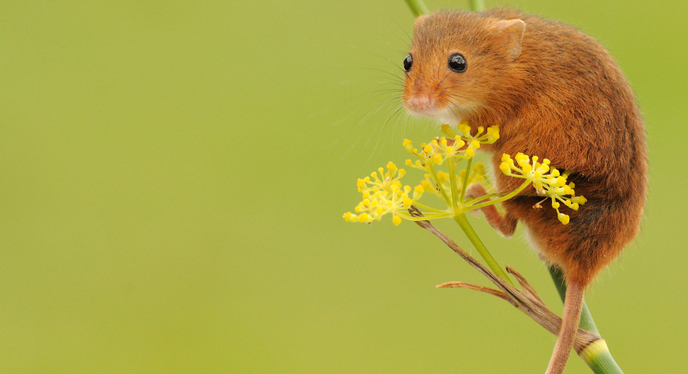Headbangers
Whilst some birds sing to attract a mate and intimidate their neighbours, woodpeckers take a different approach. They hammer their beak against a tree trunk at incredibly high speeds – up to 40 strikes per second for the great spotted woodpecker. There’s no denying that’s impressive!
There’s been some debate about how woodpeckers can cope with the strain of repeatedly banging their head against a hard surface. For a long time, it was thought that woodpeckers had spongy skulls that absorb some of the impact and protect the brain – people have even copied this idea to create safety helmets. But a study published last year disputed this common belief, showing that there is no cushioning effect. The woodpeckers use their head as a stiff hammer, not a shock absorber. Instead, it’s their small size that protects their brain, as smaller animals can withstand higher deceleration. Woodpeckers just shrug off blows that would give us a serious concussion.
Picky peckers
Any musician will know that the quality of your instrument can make a big difference to your performance. The same is true for woodpeckers, so it’s important that they find the right ‘drum’. They’re looking for something resonant, and often choose hard dead branches. Regular woodpecker watchers may have witnessed them moving from one dead branch to another, giving each a roll as if testing the sound quality. When a bird finds a branch it likes, it may come back to drum against it again and again. It’s not just trees that attract them – they’ll sometimes use man-made structures, including metal poles.
For most birds in the UK, it’s only the males that sing. When it comes to woodpeckers, drumming is often a unisex activity. Both males and females will drum to defend their territory from outsiders.
It’s all in the rhythm
Woodpeckers across the world aren’t all drumming to the same tune. The rhythm can differ from species to species – a combination of the duration of the roll, the number of strikes, and the strikes per second. A study of North American woodpeckers found that birds reacted more strongly to the drumming of their own species, though they would still react to other species with a similar drumming cadence.
Scientists have speculated that the drumming pattern could even allow woodpeckers (and the people who study them) to identify individual birds – that each bird has a signature tune. A team in Poland investigated this by analysing the drumming of 41 great spotted woodpeckers. They found that on average males drummed slightly faster than females – but there was enough overlap that they couldn’t always be certain which sex a recording belonged to. Their results also suggested that you could discriminate between individual woodpeckers based on the speed and number of their strikes. Once again, this couldn’t be done with 100% accuracy, and more evidence is needed to see if individuals change their drumming style over time.
It may be that drumming is just part of the process woodpeckers use to identify each other, along with looks and calls. A recent study of middle-spotted woodpeckers (a species found in continental Europe) showed that they can distinguish between the call of their partner and that of a stranger. A useful skill when you have a territory to defend!
British birds
There are three species of woodpecker that nest in Britain, but only one that you’re likely to hear drumming – the great spotted woodpecker. It’s our most common species, found in many woodlands and parks. Great spotted woodpeckers are glossy black and white birds with a splash of red beneath their tail – males also have a red patch on their nape. Their drumming is a short, explosive burst of strikes so fast that they blur together. Each drumroll usually lasts less than a second. The strikes speed up towards the end of the roll, but get fainter at the same time so that they seem to trail off.
Lesser spotted woodpeckers, as the name implies, are smaller. But their name now takes on a more tragic meaning, as they’re also far less likely to be spotted – or heard. They’ve declined so dramatically that they’ve been lost from most of Britain. The drumming of a lesser spotted woodpecker is slightly slower than that of a great spotted, with the individual strikes more clearly heard. It also typically lasts for longer, well over a second, at a steady pace without the acceleration towards the end.
Our final woodpecker is also our largest. The green woodpecker is a chunky bird with a moss green back and a bright red cap. They often forage on the floor, probing for ants with their long, sticky tongue. They rarely drum and when they do it’s hard to hear – a soft series of rapid taps. They prefer to display with their loud, laughing calls.
Discover our best sites for hearing drumming woodpeckers for yourself at:



